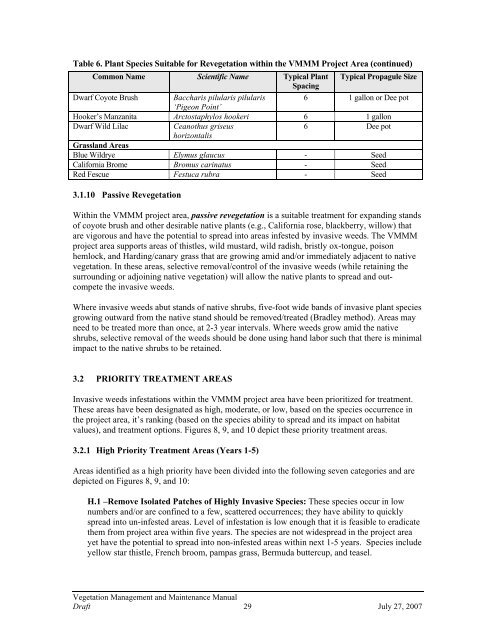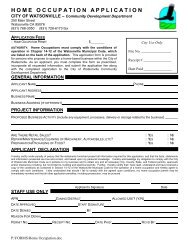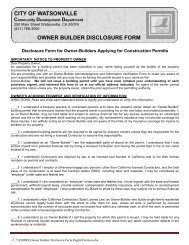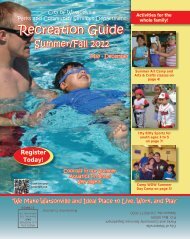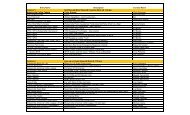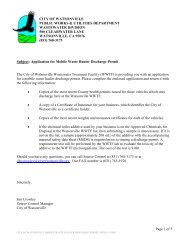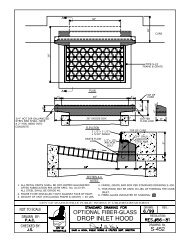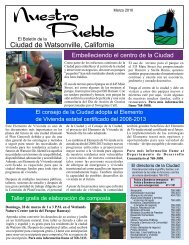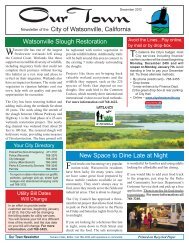Vegetation Management and Maintenance Plan - Watsonville ...
Vegetation Management and Maintenance Plan - Watsonville ...
Vegetation Management and Maintenance Plan - Watsonville ...
Create successful ePaper yourself
Turn your PDF publications into a flip-book with our unique Google optimized e-Paper software.
Table 6. <strong>Plan</strong>t Species Suitable for Revegetation within the VMMM Project Area (continued)<br />
Common Name Scientific Name Typical <strong>Plan</strong>t Typical Propagule Size<br />
Spacing<br />
Dwarf Coyote Brush Baccharis pilularis pilularis<br />
‘Pigeon Point’<br />
6 1 gallon or Dee pot<br />
Hooker’s Manzanita Arctostaphylos hookeri 6 1 gallon<br />
Dwarf Wild Lilac<br />
Ceanothus griseus<br />
6 Dee pot<br />
horizontalis<br />
Grassl<strong>and</strong> Areas<br />
Blue Wildrye Elymus glaucus - Seed<br />
California Brome Bromus carinatus - Seed<br />
Red Fescue Festuca rubra - Seed<br />
3.1.10 Passive Revegetation<br />
Within the VMMM project area, passive revegetation is a suitable treatment for exp<strong>and</strong>ing st<strong>and</strong>s<br />
of coyote brush <strong>and</strong> other desirable native plants (e.g., California rose, blackberry, willow) that<br />
are vigorous <strong>and</strong> have the potential to spread into areas infested by invasive weeds. The VMMM<br />
project area supports areas of thistles, wild mustard, wild radish, bristly ox-tongue, poison<br />
hemlock, <strong>and</strong> Harding/canary grass that are growing amid <strong>and</strong>/or immediately adjacent to native<br />
vegetation. In these areas, selective removal/control of the invasive weeds (while retaining the<br />
surrounding or adjoining native vegetation) will allow the native plants to spread <strong>and</strong> outcompete<br />
the invasive weeds.<br />
Where invasive weeds abut st<strong>and</strong>s of native shrubs, five-foot wide b<strong>and</strong>s of invasive plant species<br />
growing outward from the native st<strong>and</strong> should be removed/treated (Bradley method). Areas may<br />
need to be treated more than once, at 2-3 year intervals. Where weeds grow amid the native<br />
shrubs, selective removal of the weeds should be done using h<strong>and</strong> labor such that there is minimal<br />
impact to the native shrubs to be retained.<br />
3.2 PRIORITY TREATMENT AREAS<br />
Invasive weeds infestations within the VMMM project area have been prioritized for treatment.<br />
These areas have been designated as high, moderate, or low, based on the species occurrence in<br />
the project area, it’s ranking (based on the species ability to spread <strong>and</strong> its impact on habitat<br />
values), <strong>and</strong> treatment options. Figures 8, 9, <strong>and</strong> 10 depict these priority treatment areas.<br />
3.2.1 High Priority Treatment Areas (Years 1-5)<br />
Areas identified as a high priority have been divided into the following seven categories <strong>and</strong> are<br />
depicted on Figures 8, 9, <strong>and</strong> 10:<br />
H.1 –Remove Isolated Patches of Highly Invasive Species: These species occur in low<br />
numbers <strong>and</strong>/or are confined to a few, scattered occurrences; they have ability to quickly<br />
spread into un-infested areas. Level of infestation is low enough that it is feasible to eradicate<br />
them from project area within five years. The species are not widespread in the project area<br />
yet have the potential to spread into non-infested areas within next 1-5 years. Species include<br />
yellow star thistle, French broom, pampas grass, Bermuda buttercup, <strong>and</strong> teasel.<br />
<strong>Vegetation</strong> <strong>Management</strong> <strong>and</strong> <strong>Maintenance</strong> Manual<br />
Draft 29 July 27, 2007


